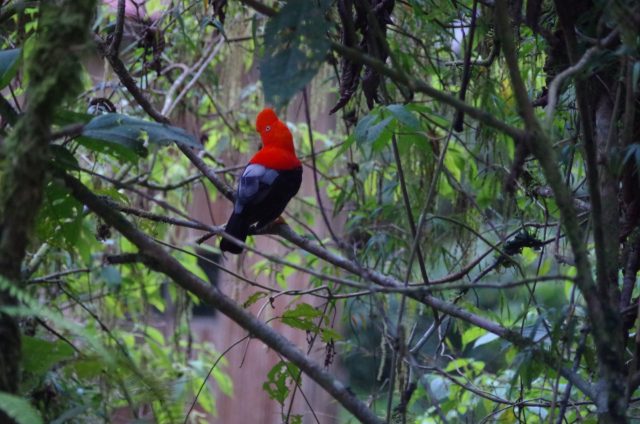All photos: Copyright (c) 2015 by Mark Justice Hinton. All Rights Reserved.

First photo of male Cock of the Rock (above)
I first heard of the Cock of the Rock years ago, after Merri led an impromptu expedition in Ecuador in search of the bird described as both showy and shy.
Last November, we were riding in a van for hours along miles of dirt road that skirt an edge of the Manu jungle region of Peru. Much of that day consisted of riding, stopping, getting out, standing by the road to look for birds while other vehicles roared pass. As we slowed for a turn before crossing a beautiful wide stream, the first Cock of the Rock male I’d ever seen landed on a branch, perhaps not 6 feet from my window (photo above). Snap! Be ready for your opportunities.
(The first female Cock of the Rock I saw was barely visible on a nest in shadow under an overhang above the Urubamba river in Aguas Caliente, near Machu Picchu. Dave Mehlman and I were wandering when a bus driver asked, “have you seen the Cock of the Rock on the nest?” Well, no actually.)
To me, the Cock of the Rock is simultaneously beautiful and ugly. The shape of the head defies logic. Look closely for the beak barely protruding from the feathers. The stark eyes are fish-like, or like the eyes pasted on stuffed animals. Yet the power of the intense red contrasting with the dapper grey and black is undeniable.
The next day, our group drove to a roadside viewing area adjacent to a lek, the competitive breeding grounds for Cocks of the Rock. Plastic tarps formed a wall to minimize dust and noise from passing vehicles. A local guardian kept the key to a locked gate that blocked the steep steps down to a narrow uneven path a dozen paces to a viewing stand, not a blind, but a rickety porch without other attachment, directly behind the plastic tarps. This viewing area looked down a hill that was dense jungle.
At the worst time, more than a dozen people jostled quietly on this platform for a chance to see and photograph one of the half a dozen or so Cocks of the Rock, mostly showy males. Viewing was very challenging through the tangle, though it’s easy to scan green for brilliant red. The loud sore-throat croak of the males also helps you find them.
Photographs required manual focus. There were just too many points to distract autofocus, but automatic exposure settings worked fine. Though the jungle was dim, these birds don’t move very fast.
Eventually, the flock of birders moved on, leaving just 3 of us to watch longer. During this time, the birds moved closer, still not as close as that first bird. It was a delightful moment.





More photos from Peru (about 170)
All photos: Copyright (c) 2015 by Mark Justice Hinton. All Rights Reserved.